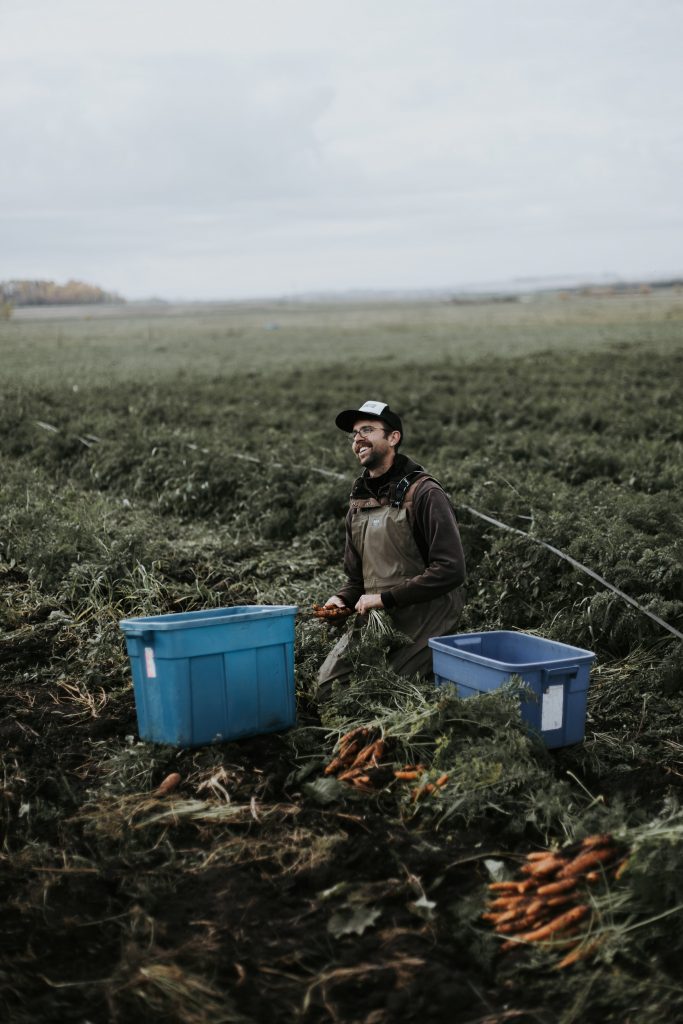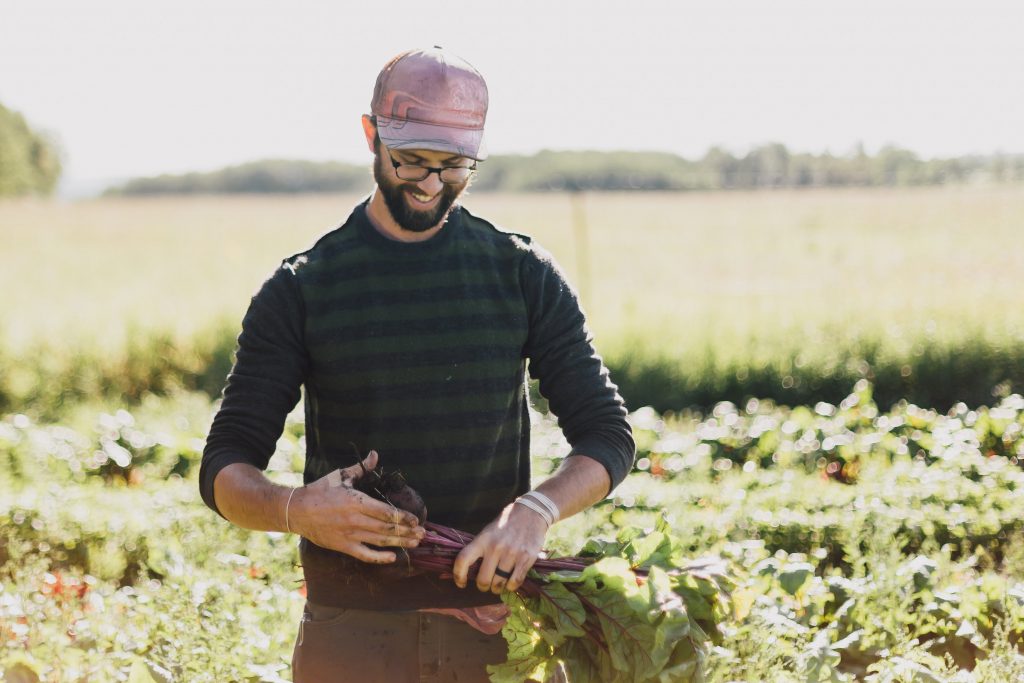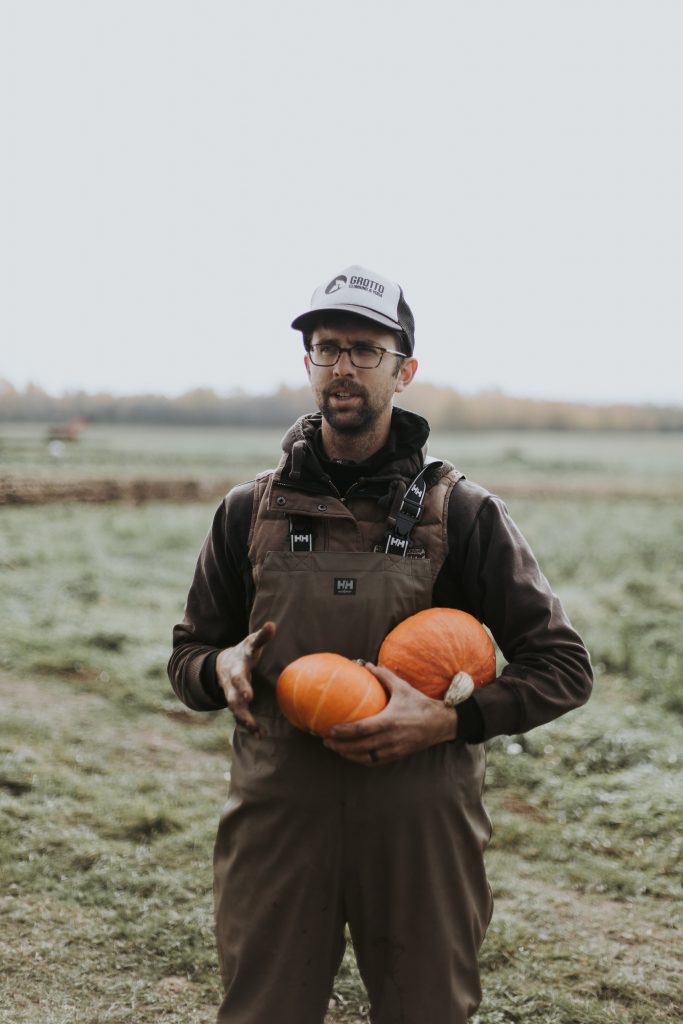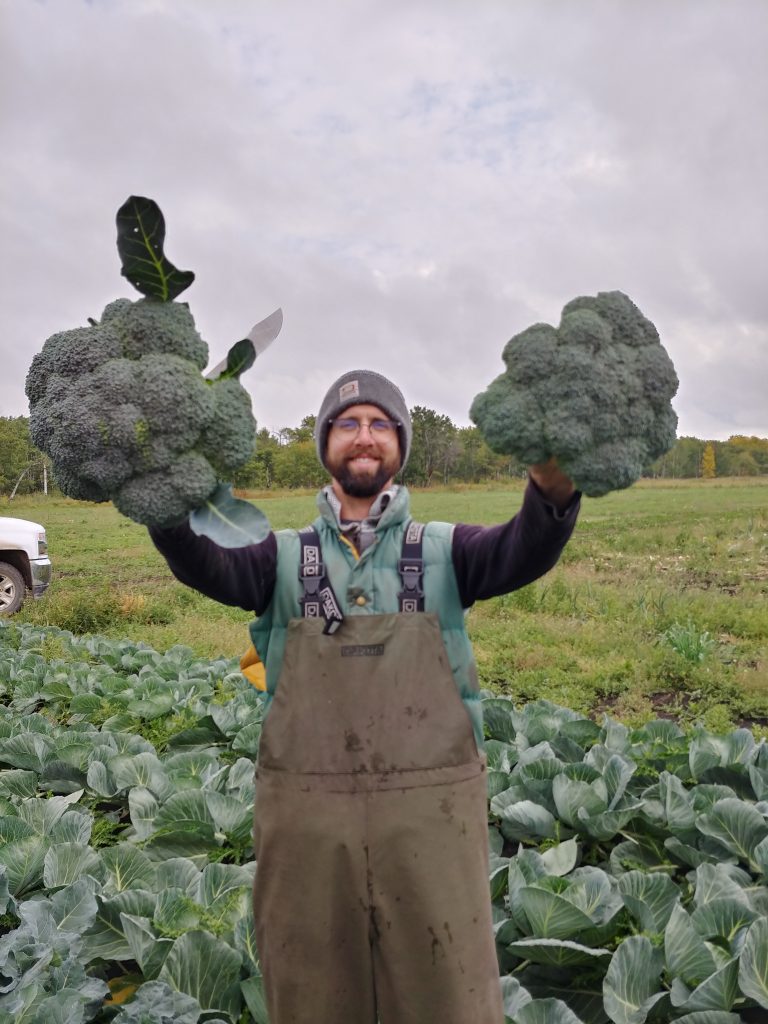
By Mike Kozlowski
Winter 2020
I started my vegetable farm on a rented piece of land in the Red Deer River valley in the fall of 2010. I was a city kid who caught the farming bug. I traveled across Canada and abroad to learn hands-on about agriculture. I spent a summer in a tiny rural village in Kenya fascinated by traditional food production methods, spent two summers traveling to over two dozen farms in British Columbia, Alberta, Nova Scotia, Quebec and Ontario, and participated in a full-season internship on a small family vegetable farm in Quebec.
With no knowledge about food production prior to these experiences, my learning curve was exponential. I became familiar with field crops, beef, dairy, goat, sheep, pig, broiler, egg, honey, vegetable, and fruit production. By engaging in a diversity of production methods, I observed the impact these methods had on the plants and animals being produced. In general, I saw that when farmers prioritized soil biology, as opposed to short term yield increases through the use of synthetic chemicals, they created healthier farming systems, healthier plants, healthier animals, and more successful farms – in terms of a triple bottom line.
In pastures, gardens, and around kitchen tables, I had hundreds of conversations throughout those years about food production. I feel fortunate that through my many mentors I came to value food as a unique expression of ecosystem function, place, and a symphony of biological processes.
Plants modify their environment. From a 40,000 foot ecological perspective, this is one of the main roles that plants play in an ecosystem. The history of earth, when you attempt to read the 4.5 billion year old book, is largely the story of how organisms have modified their environments to increase the planet’s biological carrying capacity. All living things on earth, with the exception of humans in our current sociological iteration, are part of an economy of minute exchanges and interactions that work to build the earth’s ecological capital.
More and more, I see that my role as a farmer is to foster an environment that is supportive of the natural process of nutrient cycling of generation and decomposition, and photosynthesis and death.
 In general, a traditional commercial vegetable garden is not an environment that supports a strong nutrient cycle and soil that is teeming with biology. Soil disturbance through tillage and the application of chemicals breaks up the arbuscular mycorrhizal fungi network that transfers nutrients throughout the soil and feeds plants. It also breaks up soil aggregation and decreases soil organic matter, both of which provide habitat for beneficial soil organisms and play a vital role in water infiltration. The black soil between plants and in walking rows, which is the near constant backdrop of a commercial vegetable garden, is a lost opportunity for photosynthesis which sequesters carbon and feeds the community of life in the soil.
In general, a traditional commercial vegetable garden is not an environment that supports a strong nutrient cycle and soil that is teeming with biology. Soil disturbance through tillage and the application of chemicals breaks up the arbuscular mycorrhizal fungi network that transfers nutrients throughout the soil and feeds plants. It also breaks up soil aggregation and decreases soil organic matter, both of which provide habitat for beneficial soil organisms and play a vital role in water infiltration. The black soil between plants and in walking rows, which is the near constant backdrop of a commercial vegetable garden, is a lost opportunity for photosynthesis which sequesters carbon and feeds the community of life in the soil.
Many intrepid vegetable farmers, however, are doing fantastic work. Many good vegetable farmers have been practicing cover cropping, minimizing tillage, and decreasing or completely getting rid of chemicals for a number of years. As important as these steps are, I see them as just the first steps to growing food that is part of a truly regenerative system.
Decades ago, holistically managed cattle operations figured out how to produce food in a way that regenerates land and creates profitable businesses that offer invaluable ecosystem services to their communities. In my opinion, planting a cover crop every other year doesn’t seem to be enough compared to managing a lush pasture covered in plants every day of the year. I would rather find a way to fill most, or all of the black space in my garden with photosynthesizing plants that sequester carbon, increase soil aggregation, and mimic the natural ecosystem that was disturbed to create space for the vegetable garden.
In our climate, with my soil type, with the natural resources available in our community, there is no exhaustive how-to manual to create a truly regenerative garden. And so, I am doing my own experiments to explore how I can change my production methods to be more aligned with my values.
 Regenerative agriculture describes a system that prioritizes nutrient cycling and photosynthesis as a way to build soil organic matter, sequester carbon, repopulate the biological community in the soil, and restore ecosystem function.
Regenerative agriculture describes a system that prioritizes nutrient cycling and photosynthesis as a way to build soil organic matter, sequester carbon, repopulate the biological community in the soil, and restore ecosystem function.
As I look for solutions to grow vegetables in a way that can be a part of restoring ecosystem function, the five tenets of regenerative agriculture provide a broad road map that directs me toward effective practices:
- Minimize soil disturbance
- Keep living roots in the soil as long as possible
- Prioritize diversity
- Provide a layer of cover on the soil
- Incorporate animals
I am starting to use these tenets as a rubric in decision making. I can compare decisions I make on the farm to these categories to help me decide if the decisions are in alignment with the direction of life. If a given decision supports progress in one or more of these categories it is likely a regenerative practice.
In the summer of 2019, I did two experiments that gave me insight as to how I can shift my practices to be more supportive of the complex web of life that these plants need to better express their genetic potential. I understand these are not double blind, randomized control trials. The evidence I have gathered through these experiments, however unscientific, is strong enough for me to continue to implement the methods I have experimented with more broadly.
Experiment #1
I plant broccoli two rows to a bed with in row plant spacing of 18 inches. Last year I had some extra head lettuce seedlings and decided to transplant them in the same bed as my spring planting of broccoli. I transplanted the lettuce in between broccoli plants and also added a third row in between the broccoli that was exclusively dedicated to lettuce. In doing this I increased diversity, increased the protective layer over the soil, and increased the amount of time that living roots were photosynthesizing in the soil. I was delighted to find that the broccoli plants in the experimental row grew approximately 15 percent faster than the broccoli in the control row directly adjacent to them. All other variables were the same. I made progress in three of the five categories, so I consider this a regenerative practice that I will continue to develop in the future.
Experiment #2
This experiment also focused on a spring broccoli crop. For the past three seasons, I have been reducing tillage, although, before transplanting, I still prepare the bed through some type of tillage. For my control, I used a perfecta field cultivator to prepare the beds for planting broccoli. For the experiment, I planted broccoli in a bed that hadn’t been disturbed since July 2018. In these beds, instead of cultivation, we used a broad fork to loosen the soil to make transplanting easier. I also added 1-2” of compost that I created on the farm.
After transplanting brassicas, I frequently scout for signs of cabbage looper infestation. In the control, I found evidence of the pest in early July and decided to spray with BTK, a biological insecticide, to mitigate crop loss. Growth in my brassica crops was prolific this season and so I harvested the main crop from the control followed by three crops of side shoots. It was necessary for me to spray BTK weekly in order to avoid crop loss.
In the experimental crop, I saw no sign of the cabbage looper until after harvesting the main crop followed by one harvest of side shoots. My interpretation of these results is that the conditions I created by not disturbing the soil, and through the addition of compost, supported the healthy development of the biological community in the soil. When the broccoli plants sent out their request for nutrients, the soil community heard and was able to respond. As a result of having their nutritional demands met, the broccoli plants were able to produce secondary metabolites that gave them the ability to resist the pest. It was interesting to observe that after the harvest of the main crop, followed by the side shoots, I was able to see the color of the leaves pale slightly, at which point vigorous growth decreased. Overall plant health decreased and the pest was able to feed on the plants.
 In conducting this experiment I decreased soil disturbance and provided a layer of cover over the soil. Arguably, by applying compost I was adding and feeding microscopic animals to my soil so this experiment checks three boxes off of the regenerative agriculture checklist.
In conducting this experiment I decreased soil disturbance and provided a layer of cover over the soil. Arguably, by applying compost I was adding and feeding microscopic animals to my soil so this experiment checks three boxes off of the regenerative agriculture checklist.
Observing the impacts that these experiments had on plant growth helped to debunk two paradigms of commercial vegetable production: 1) that tillage is necessary, and 2) that plants compete for nutrients rather than cooperate and share resources.
I’m excited to implement these practices on a larger scale and continue to discover how I can build the nutrient cycling capacity in my garden, support the biological community, and maximize photosynthesis.
However, as I contemplate how I can implement these changes on a larger scale, I run into a number of challenges. For example, there are four common ways to implement no-till in a vegetable garden: deep compost mulch, deep mulch, crimping a cover crop, and using tarps.
Under the deep compost mulch method (which I used in my experiment), growers apply 2 to 8 inches of compost to the top of their beds. Over time, compost softens the soil to facilitate transplanting and smothers out the weeds. In an 8-acre garden, this would be over 1400 cubic yards of compost, which is way more than I can make on farm. In my area there is a lack of compost that meets the requirements I need in order to make this method work. So, at best, I can only mulch a small section of the garden each year.
Using the deep mulch method, growers apply up to a foot of an available carbon rich resource – straw, leaves, hay, etc. – to their fields before or after transplanting and seeding. In the past, I have used this method in my garlic crop, using straw as a mulch. In general, I’ve been disappointed with weed suppression, and in wet years, I’ve encountered issues with rot.
Alternatively, crimping a cover crop and planting directly into it suppresses weeds, while also softening the soil to facilitate transplanting and seeding. My growing season is much shorter compared to farmers further south who use this method. In order for this method to work on my farm, I would only be able to use it for late summer plantings (which are rare for me) or by growing a mid to late summer cover crop which I would roll over to plant into the following spring. For logistical reasons and space concerns this method isn’t extremely practical for my operation.
Using tarps is an effective method to suppress weeds until a bed is ready to plant, thus decreasing the need for tillage. Most of the growers using this method are growing on less than one acre. Scaling this up to 8 acres would be extremely expensive and would use a lot of plastic, something I am working to get away from.
None of these common methods are a panacea for my farming project. Used in conjunction, however, and with the addition of living mulches and the retooling of my farm equipment to facilitate seeding and transplanting into higher trash situations, I see how no-till and other regenerative production methods will be valuable tools on my farm.
—

Steel Pony Farms
Mike Kozlowski, owner of Steel Pony Farms, grows approximately thirty varieties of vegetables on eight acres of rented land just outside of Red Deer, Alberta. He runs a weekly food box program from july through December that supports close to 300 families to east fresh, nutriotious, locally produced vegetables.
Learn more about Steel Pony Farms – https://steelpony.ca

